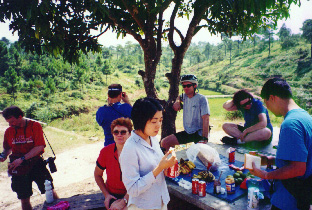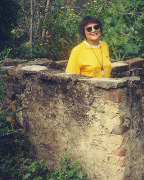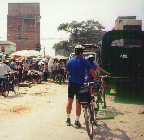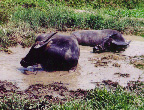

|
(from Sonnet XVI, Feng Chih) translated by Kai-Yu Hsu |
Nanning had been a nice way to erase the jet lag, but it was time to head south. In the best cycling tradition, we boarded the now-familiar bus after breakfast so that we could get out of town in comfort and style. The bus trundled its way to the southeast, 20 miles or so, to a less-trafficed road just beyond the town of Datang. Without knowing it, we had also crossed out of the valley of the Yongjiang River and into a much smaller watershed drained by the Ch'in Chiang River. (The Yongjiang flows east to Guangzhou, joining other rivers and empties into the Pearl River delta, which is bracketed by Hong Kong and Macau.) |
|
|
|
|
 The latest in outdoor convenience: a "loo" with a view. (photo by gail thompson)
|
We dumped our stuff out by a couple of small huts, and began the lengthy preparatory rituals of American riders, smearing sunscreen, checking the film in the camera, choosing just the right items to take on the ride. The intrepid women discovered a water closet perched on the far side of the road&emdash;an unroofed brick enclosure about 4 feet high and 6 feet square. Of course, there was no flushing mechanism, just a hole on the far end opening onto the steep hill slope where we presumed the 'fertilizer' was intended to go. The road south was narrow but mostly paved and not heavily traveled. The route generally trended downhill, following the river valley towards the coast. Aside from a little repair work on one stretch, the road was in good condition, a little patched and a little worn like any backcountry road in the U.S. But we did find some inclines, and the heat of the late morning and afternoon helped us work up a respectable sweat.
|
|
 The new town: Robert and Stephanie choose to walk their bikes behind the slow-moving line of buses and trucks. (photo by gail thompson)
|
After a dozen miles or so we entered a town that appeared to be under construction or major reconstruction. The treeless streets were unpaved and clouds of dust swirled around the trucks and bicycle traffic as we bumped our away along between buildings new and half-finished. I was ahead of most of the group and ended up riding closely behind one truck, which increased the shock effect when the foot and wheeled traffic coming from the other direction got a sudden glimpse of a crazy American with a bicycle helmet and shorts and all the other accoutrements that we have to have before we can start pedaling. The road led up onto a forested hill with some older buildings and I stopped along the shaded road to wait for the others. Of course, this engendered some curiosity in the people walking and riding by. One or two of them stopped to ask me questions, but the language barrier made things difficult. I pointed down the road and said "Feng Cheng" and "Hanoi" a couple of times. Then I pulled my map out of my rack trunk and showed them the route. It took them a little while before they recognized some of the city names and realized that the blue represented the South China Sea. This occasioned some mild excitement &endash; they may have thought I was lost, at least until other members of the party started showing up. There was some talk of a lunch spot up ahead where the van was waiting for us. Our guides had appropriated a small primary school for our purposes; it was perched on a small hillock with a steep driveway of dirt and rock, carved by erosion. I believe that this was the first day we had a westernized "picnic lunch," which I found a marvelous relief even though it consisted mainly of peanut butter sandwiches and chocolate chip cookies.
|
|
(photo by richard beattie) |
It was midday, so school was out as we grubbed out in the shade, trading places on the sole bench under the tree in front of the school gate. As the hour approached 2 o'clock, children started coming up the path, some in pairs, some accompanied by older siblings. The first few were timid, shrinking from us as they tried to find the shortest route to the gates and the safety of the school yard. As more of them gathered in the yard, they became bolder, and would edge out of the gate to get a closer look. We found that any attempt to photograph them would send them scattering back inside. However, Johnny was able to coax them out with his video camera, which had a fold-out screen that showed their faces while he was filming them. That won them over completely, as they began jostling and laughing, trying to get to the front of the pack to mug for the camera. The lure of the video was so powerful that not even the occasional flashes from our still cameras concerned them.
|
|
 Another outdoor convenience, most welcome on a hot day. |
Regrettably, we had to leave this idyllic scene behind and continue towards the coast. The valleys were mostly rice paddies with some sweet potato, sugar cane, and other crops. The slopes had some narrow terraces, that appeared to be used for other purposes than rice. Every now and then we would see a water buffalo, or a person in a conical hat in the distance, working in the green fields. Aside from the hats, the landscape reminded me very much of Bali, with shades of green so rich and distinctive that no Western adjectives would serve. After a few brief climbs, we were on a long, sailing, mostly downhill course to the southern city of Feng Chang. The road broadened into a boulevard as we entered town, with the familiar ground-level shops, open to the street. I was passing a long row of waiting cyclos and beginning to worry about directions when I saw Daisy up ahead at the traffic circle, waving to indicate we should pass through and continue to the left. A half block further down we came to the hotel.
|
|
|
If I recollect, dinner that night was in the hotel. I'm sure that it included many courses of duck, pork, and soundly sleeping fish. Afterwards, a smaller party went out in search of a rumored "cybercafe." What we found was not as elegant as all that -- one of those simple ground-level shops, completely open in front, with several locals playing computer games at PCs lined up along each wall. A woman in uniform hovered over us briefly; for a moment I thought she was there to monitor the activity. But there was little to monitor. The resident computer guru, appearing to be high school age, was unable to establish a dial-up connection. They apologized and pointed to the line work outside. The street was being rewired for something and so we were off the air. They suggested some neighboring shops, but the whole street was dead as far as phone lines were concerned. Back on the main street there was one more chance, a dark little place that seemed to be closed, and here we found our luck. The shop sprang to life at the prospect of paying customers, and soon had two or three terminals logged in to the Web. We exchanged tips as we tried to get into our old Yahoo! and Hotmail accounts, and found in many cases we had to create new ones. But in about 20 minutes, and for just a few yuan, we had flooded the western hemisphere with eagerly-anticipated reports of our journey. |